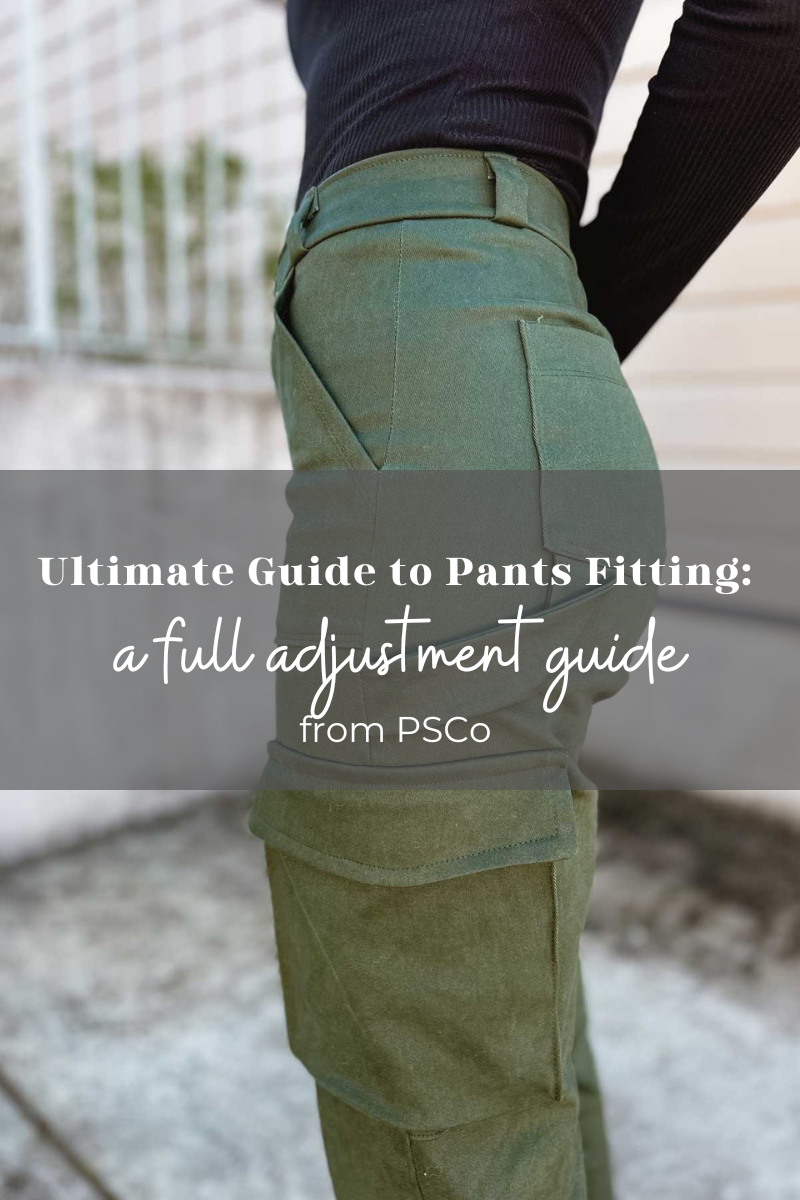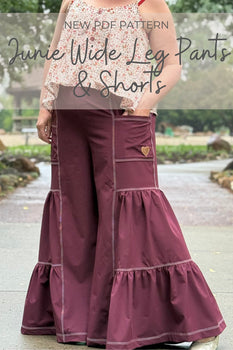
Ultimate Guide to Pants Fitting
|
|
Time to read 12 min
It's 2025, friends. Are we really going to continue to put off sewing "real" pants?
And yes, I know all pants are technically real pants but the kind I am talking about have zippers and buttons and inspire fear in the hearts of sewists everywhere. Let's make this the year that we tackle all those sewing challenges that have been holding us back- starting with a well fitting pair of pants!
I won't lie to you and say that pants fitting is a breeze, but it's definitely doable with the right resources. And since I am starting off the year by challenging you to step outside your comfort zone of stretchy things and tackle woven pants, it's only fair that I compile all those resources into one place for you! (please, hold your applause! lol)
In this guide, I’m sharing everything I’ve learned about pants fitting over the years- from diagnosing the problem areas to making adjustments that actually work for you.
Table of contents
Let's get it!
Before we dive into examining the fit, let's take a look over some measuring and fitting info that will help you through this process.
All patterns will have different sizing info and you should always refer to the info in the specific pattern that you are sewing, but let's go over the basics.
- Waist- in this diagram the waist refers to the natural waist which is usually the smallest part.
- Low waist- this is around 2" below the belly button and the fullest part of the tummy.
- Hip- this refers to the fullest part of the hip/booty.
- Thigh- the thigh measurement is taken at the fullest part of the thigh and is usually about 1" down from the crotch.
- Calf- the calf measurement refers to the fullest part of the calf.
- Inseam- this is measured from the crotch to the floor. Depending on where you want your pants to hit, this can be longer or shorter than the finished inseam of the pants. I always measure my inseam wearing the shoes I will likely wear.

Understanding the Pattern Pieces
To the right you will see a a front and back pant pattern piece. This pattern specifically is the Calloway Cargos. Before we get into fitting and adjustments, let's go over some areas on the pattern pieces that you will want to locate/mark.
- Hip Line: this is the widest part of the hip. You can typically find this by looking at the hip curve if it is not marked on the pattern. This should match up to the full hip on the body.
- Knee Line: this will hit at the center of the knee cap. On a 30" inseam, this is about 16" from the bottom of the pants.
- Rise: this refers to the front and back crotch curves. Your pants will have a front rise and a back rise. Sometimes this is also referred to as crotch length.
- Grainline: the grainline on the pattern piece should be matched up to the grainline on your fabric.
Your pants may also have other placement markers, darts, balance lines, etc.

Understanding Rise
Rise is the vertical measurement between the crotch seam and the top of the waistband. Your pants will have a front and back rise. Some patterns (like the Calloway Cargos) will have these measurements listed in the finished measurement chart. For those that don't, you can easily calculate this by using your pattern pieces.
To calculate the rise, start by marking the stitching line by measuring off the seam allowance for the pattern for both the crotch curve and the waistband. Then simply measure those lines, subtract the seam allowances for the pants and waistband, and add the two together! You will repeat this for both the front and back pieces.
Knowing the rise is important because that will let you know where the pants are going to hit on your body. Knowing where the pants will hit can allow you to take a more accurate waist measurement and let you know if you need to add or remove length from the rise.

Measuring Your Rise
Personally, I find it easier to measure rise when I am already wearing a well fitting pair of pants. This allows me to see where the seam is hitting me comfortably. I find that makes it easier to make adjustments later.
Of course there are more detailed and anatomically accurate ways to determine where to measure your rise, but we are covering the route that is going to be easiest!
Once you locate the crotch seam, you will want to measure from that seam, over the pubic bone and up toward the belly button (shown in purple). This measurement will give you your front rise.
For the back rise, you will want to locate that seam again and go the opposite way and up over the booty and towards the lower back.
Rise can be affected by a few different factors including height and body projection. We will talk about that a little more in just a bit!

Pants and Proportion
To the left you will see a diagram of the relationship of pants to the body. As you can see all of the lines are matching up where you would expect.
The hip line falls even with the widest part of the hip. This means that the fullest part of the pants pattern will match up perfectly with the fullest part of the hip.
The knee line is also matching up correctly with the knee. This means that the length proportions of the lower leg are correct. The inseam length also looks accurate for the wearer.
When we get to the rise, you can see that the rise is hitting the wearer where you would expect. This means that the crotch depth (or rise) is correct. Looking horizontally, you can see that the crotch width is also correct. Crotch width refer negative space between the crotch curves where the body will sit.
Crotch width is where a lot of our fitting issues will likely come from. Since crotch width relates greatly to the shape of the body and body projection, it needs to be just right for you to get the correct fit. Let's explore that a little more.

Body Projection
Body projection refers to the fullness of the body and how it relates to the frame. This can be anything from a fuller bust, larger tummy or booty, or even large quads/prominent thighs.
If you are a person with a narrow frame and a large bust, you can easily have the same bust measurement as a person with a wider frame and smaller bust. This is where a full bust adjustment would be needed to get the proper fit. The same is true for pants as well- projection will affect your fit, sizing, and adjustments.
As you can see between the two bodies on the right, the second has more projection in the tummy/butt than the first. However, it is very possible that these two bodies could have the exact same waist and hip measurements but the same size pair of pants would look very different on each person.
This is why understanding how to sew for your body is so important!

Projection & Balance
You can't address any fitting issues until after you have made your muslin. I suggest sizing yourself according to the tutorial and then sewing up a muslin in a fabric similar to that of your final pair.
There are different tell-tale signs that you need an adjustment based on drag lines and loose/tightness but the first thing that I always look at is the side seam. It is a great indicator of any fitting issues that will relate to body projection. Pants will always "borrow" fabric where they need it which can cause the shifting and warping of seams as you see here.
Take a look at the first pair which are well balanced and fit well. The side seam runs perfectly parallel to the body. Now take a look at the middle pair. You can see that the booty is a little larger and that side seam is getting pulled toward the back. This means that there needs to be more room in the back to accommodate the booty and balance out the pants. The opposite is true for the last pair. The wearer has a smaller booty and larger tummy so that side seam is getting pulled toward the front.

Here's the thing with pants fitting- sometimes it's really hard to tell what the heck is going on and where your issues are coming from. Starting at the vertical balance of the pants (the side seam) is a great way to get you pointed in the right direction.
We are almost ready for the good stuff- the Adjustments Guide! Before we get started there, let's go over a few quick reminders and tips for sewing your muslins and making adjustments!
- Measure according to the directions in the pattern tutorial. I can't stress accurate/current measurements enough!
- Make your muslin with fabric that is similar to the fabric that you will be using for your finals. If you are using a woven non stretch denim, you do not want to use a ponte for your muslin.
- Baste your seams- specifically the side and crotch seams. Sometimes you can make small adjustments to the pattern pieces without having to cut a new muslin. This saves you time and fabric!
- Only adjust one thing at a time. Sometimes adjusting the back can affect the fit of the front and vice versa. If you adjust both at once and something doesn't help- you don't know what worked and what didn't.
- Adjust small amounts at a time. For crotch/seat adjustments, I typically use between 1/4" and 1/2" increments- max! A little there can make a big difference.
- You can cut your pants shorter to save fabric but I suggest going at least to the knee. This will allow any drag lines to become visible that may help you determine a fit adjustment that needs to be made.
Adjustment Guide
Length Adjustments
Length adjustments are some of the most common adjustments in bottoms. When adjusting the length it is important to remember that we need to keep the proportion of the lower leg intact so that the knee line continues to line up with the knee. A sign that your bottoms are too long is the pooling of fabric around the knees and ankles.
Many bottom patterns at Petite Stitchery include multiple inseam lengths which means less adjusting for you! If your pant pattern does not include multiple inseams, no worries- adjusting is pretty easy!
First you will need to locate the knee line and mark two points- one across the thigh and across the lower leg. From these points you will slash your pattern piece across and spread or overlap each section by half the length you want to add/remove. Redraw the side seams by smoothing out any jagged areas. You'll repeat this for the front and back.


Rise Adjustments
Rise adjustments are also pretty common. They can stem from height/torso length differences or can be needed to compensate for a projection issue like a full tummy adjustment or full/small booty adjustments. For this type of rise adjustment, we will focus on adjusting for height/torso length.
To adjust the length of the rise, you will want to slash just above the hip line of the pants. You will then spread or overlap evenly between the front and back pieces to keep your side seam lengths consistent. This type of rise adjustment will affect the total length of the pants. If you do not want to change the side seam length but need to adjust the rise slightly, you can pivot from the side seam and overlap/spread to remove/add height from the rise.


Full Belly Adjustment
A Full Tummy Adjustment can be helpful when you have a fuller lower belly. Some signs that you may need this alteration are drag lines that radiate from the stomach. You will also feel tightness and pulling in the fly/crotch seam and the side seam will be pulled toward the front of the pants. You may also notice tightness in the crotch which can mean that there is not enough rise to cover the fuller belly.
To do the Full Tummy Adjustment, slash along the hip line of the pattern at about a 45 degree angle toward the center crotch seam. Pivot from the hip line and spread to add length and width to the front.
Redraw your front seam smoothing out any jagged bits!

Full Booty & Small Booty Adjustments
Fitting the crotch and the bum are usually where we will see some problems. This is where projection matters!
If you have a fuller booty, you may notice some tightness and stress lines radiating out from the center of your bum. You may also notice a slight dip in the back waistband which means there isn't enough rise. To adjust for this, slash your back pant at around a 45 degree angle starting at the hip and spread to add length and width to the back. If you also feel like you have a wedgie, you may need to scoop out the crotch slightly as shown.
For a small booty adjustment, you will notice some extra fabric in the rear/rise. There will be looseness in the back thigh and drag lines radiating downward. To adjust for this, slash your back pant at around a 45 degree angle starting at the hip and and overlap to remove length and width from the back of the pants. You may also need to adjust for a smaller thigh as well (shown in red).


Short/Long Crotch Depth
Pants need to have the right balance of depth and width in the front and the back. For these adjustments we will focus on the front! This adjustment can also be referred to as a thick/thin thigh adjustment.
If the crotch depth is too short, you may notice that there are drag lines that start at the crotch and radiate upwards toward the hips. They can also feel like they are being pulled toward the crotch or tight in the upper thighs. To remedy this, extend the crotch point slightly.
On the opposite side, if the crotch length is too long there will be drag lines radiating downwards toward the thigh and the thigh area of your jeans may feel loose. To remedy this, take a small amount off of the crotch point.
Both of these adjustments need to be done in small increments- a little goes a long way!


Round/Flat Pubis Adjustment
The previous adjustments went over crotch depth and the next two will go over crotch width. This is the negative space between the crotch points where the body will sit.
The first adjustment that we will go over is the round pubis adjustment. If you need this adjustment you will probably notice a tell tale sign- the dreaded camel toe. The crotch of your pants will feel tight and you will have excess fabric along each side creating vertical draglines that radiate upward. This happens when the pubic bone is rounder than what the pattern is drafted for. To fix, we will scoop out the curve of the crotch making it deeper. Remember when making this adjustment to work in very small increments.
Inversely, if you have drag lines that sit vertically across the crotch you may need lessen the curve and make it slightly more shallow as shown.


Low Seat Adjustment
A low seat adjustment is needed when your booty sits a little bit lower than the pattern is drafted for.
If you need this adjustment you will notice some horizontal drag lines on the back of the thigh underneath the booty. You can also have some extra fabric in the crease of your bum. This is caused by there not being enough room in the bottom of the crotch curve.
To fix this issue, you will scoop the seat curve as shown. Creating more of an "L" shape with the seat curve will allow more room for a lower sitting booty.









